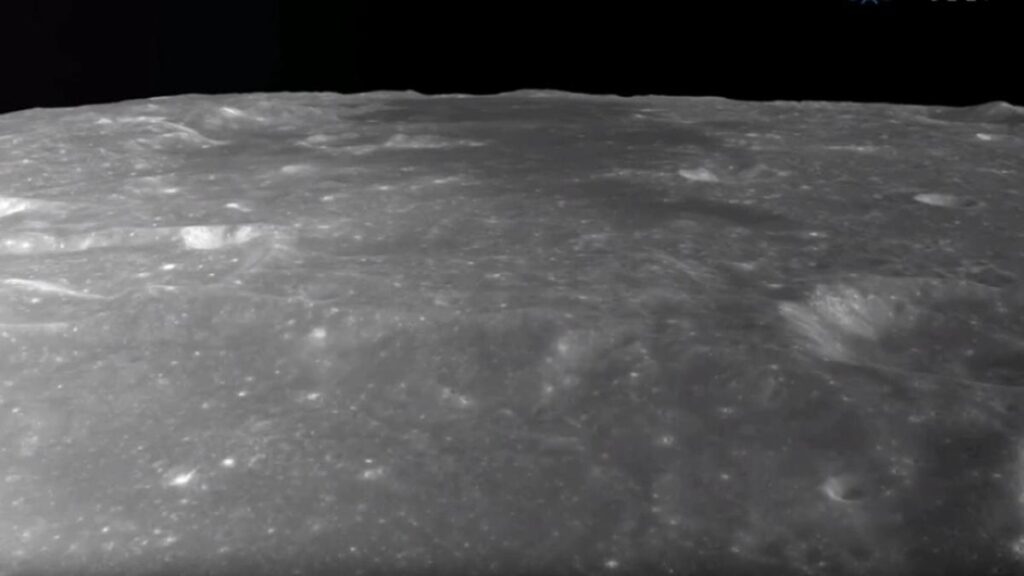China’s lunar sample collection mission, Chang’e 6, has made history by successfully landing on the far side of the moon, and even sent back a stunning video of the landing.
The China National Space Administration (CNSA) probe arrived on Sunday (June 2) at 6:23 a.m. Beijing Time, which was 6:23 p.m. on Saturday (June 1) EDT (2223 UTC). The video footage was filmed by the Chang’e-6 landing camera of the lander. It shows the spacecraft’s close approach to the lunar surface and its landing.
The video shows one area of the moon that humanity will never see from Earth. That’s because the moon is tidally locked, meaning one of the moon’s halves is constantly pointed toward our planet, while the other is always pointing out into space.
Missions to the far side of the moon have been rare, with the near side being much easier to reach and explore; So far, China is the only country to achieve a soft landing on the far side of the moon. NASA’s Ranger 4 was the first spacecraft to land on the far side of the moon in 1962, but this was an emergency landing and it could not transmit data back to Earth. This is the CNSA’s second lunar landing on the far side of the moon. In January 2019, the Change 4 mission took a lander-rover combo to the hidden lunar hemisphere.
Related: The cold lunar night may have finally swallowed Japan’s SLIM lunar lander
Humanity’s first glimpse of this elusive lunar hemisphere came in 1959, thanks to a grainy image from the former Soviet Union’s Luna 3 spacecraft. Then, in 1968, as part of the Apollo 8 mission in lunar orbit, astronaut William Anders delivered incredible images from the far side of the moon to Earth. The crew of Apollo 8 were the first people to see this lunar region without the aid of optical devices.
The Chang’e 6 video shows that the new mission is already shedding light on a mysterious region of Earth’s known moon companion.
The Chang’e 6 landing zone, named after a moon goddess from Chinese mythology, is located in the South Pole-Aitken Basina massive impact crater 1,500 miles (2,500 kilometers) wide and 4 to 5 miles (6.4 to 8 kilometers) deep.
Chang’e 6, which launched on May 3 and entered lunar orbit four days later, will now spend several days using the onboard drill to collect lunar debris, or “regolith‘ and rocks around the landing site. If all goes according to plan, the Chang’e 6 landing won’t be the only historic moment. The CNSA plans to use the robotic mission to return 4.4 pounds (2 kilograms) of lunar material back to Earth.
“The Chang’e-6 mission is the first human sampling and return mission from the far side of the moon,” CNSA officials said in a translated statement. “It involves many technical innovations, high risks and great difficulties.”
Chang’e 6 will deliver lunar material into orbit on the rocket that carried its lander unit to the moon on June 2. The Chang’e 6 orbiter, which remained in space around the moon, will pick up the sample container before parachuting it back to Earth on June 25.
RELATED STORIES:
— This is what China’s first moon landing with astronauts could look like (video)
— China’s next moon missions get the green light
— China opens Chang’e 5 moon samples to international researchers
Samples returned from the far side of the moon will be subject to intense scientific scrutiny as researchers try to unravel the secrets of this strange lunar hemisphere.
These studies include efforts to determine why the near side of the moon is marked by large, dark spots volcanic plains called “maria“While the other side is not. It is believed that Maria was formed by lava flowing into ancient impact basins.
Chang’e 6 will soon be joined on the moon by even more missions of the same name. Chang’e 7 will be launched next year and will head to the moon’s south polar region to search for supplies of water ice. Change 8 is scheduled for launch in 2028. The latter will also go to the south pole of the moon, but aims to test the in-situ use of the resources Chang’e 7 discovers and reveal how they could benefit human moon exploration. This comes ahead of the CNSA’s plan to send manned missions to the moon by 2030.

